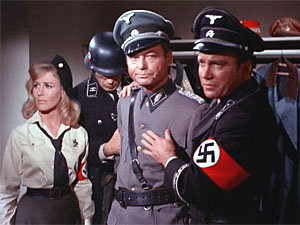 “Patterns of Force” is infamous as “the Nazi episode”. I was not looking forward to rewatching this one, remembering it as so over the top that it resembled a pantomime rather than a decent attempt at science fiction. However, I was pleasantly surprised.
“Patterns of Force” is infamous as “the Nazi episode”. I was not looking forward to rewatching this one, remembering it as so over the top that it resembled a pantomime rather than a decent attempt at science fiction. However, I was pleasantly surprised.
It begins with the Enterprise shown against not one, but two planets. We learn these are the planets Ekos and Zeon. They’re heading to Ekos to pick up Earth historian John Gill from a long stint observing the local culture. The Ekosians fire a nuclear missile at the Enterprise – it is harmlessly destroyed, but the Ekosians should not have that level of technology. They were pre-atomic at last report, though the Zeons had primitive interplanetary spaceflight. Kirk fears Gill may have contaminated the Ekosian culture, violating the Prime Directive, and decides to beam down with Spock to investigate. McCoy injects them with subcutaneous tracking devices in case they can’t radio back for some reason – this raises the question of why all landing parties aren’t routinely equipped with such devices.
They discover Ekos has a culture almost identical to Nazi Germany, with Gill himself as the Führer. Zeons who have colonised Ekos are persecuted in a transparent analogy to Nazi persecution of Jews. At this point I realised the fairly obvious mapping of “Zeon” to “Zion”, and this continued with the names of several Zeons being things like Abrom and Isak. We even see footage of the Führer announcing the “Final Decision” to rid Ekos of all Zeons. These parallels all start to strain credulity, making the entire setup seem increasingly hokey, but don’t give up on this episode just yet.
Kirk and Spock steal some Nazi uniforms and try to see Gill, but end up captured, stripped shirtless, and whipped. Their captors say they have standing orders to kill all prisoners immediately after an interrogation attempt, but a senior SS official tells him to let them suffer for a bit to see if they will talk. Kirk and Spock are thrown into a cell, where Isak is also being held – but if they kill all prisoners, why is Isak there? They break out of prison by MacGyvering a laser out of their implanted transponders and a light bulb (involving a comedy scene with Spock standing on Kirk’s raw whipped back) and join up with an underground resistance of Zeons, which also includes Daras, an Ekosian woman decorated as a hero of the Reich with the Iron Cross, but sympathetic to the Zeons. They hatch a plan to sneak into Nazi HQ and see Gill by disguising Kirk, Spock, and some Zeons as reporters filming Daras. This is amusing, as Kirk is constantly taking footage of Daras from about half a metre away.
They meet Melakon, Gill’s second in command, who it turns out is running things, with Gill heavily drugged and manipulated into giving the appearance of giving speeches. McCoy gets invited down, dressed as an SS doctor, to help revive Gill. After some fighting, they reach Gill and McCoy injects him with a stimulant, but it’s not enough to rouse him. McCoy says he doesn’t dare risk another shot, and then has to leave the room, at which point Kirk promptly injects Gill a second time. Gill recovers long enough to mutter an apology – he thought introducing Nazism would make the Ekosians into an efficient developing culture, but Melakon twisted it. It sounds a bit weird when put like that, but Spock backs him up, stating that Nazi Germany, considered without its social and war policies, was economically and technologically advanced. (Apparently this was a popular view in the 1960s, as I discovered with some research, before it was discovered the Nazi economy was in fact built on foundations of sand.) Melakon appears and shoots Gill, but Isak shoots Melakon, and the surviving senior Nazis decide war is silly and they should be friends with the Zeons.
In the denouement, Kirk declares that, “Even historians fail to learn from history and repeat the same mistakes.” It sure sounds like a hokey episode, but watching it carefully it’s surprising how tightly scripted the drama is. There’s no unnecessary padding or filler here – the episode runs to a full 46 minutes when most other episodes are about 42, and very little of that could have been cut. The allusions are certainly in your face, but there is a decent enough in-story justification for this alien planet to look exactly like Nazi Germany, once you get to it. And the moral lesson is also pointed, but again, it makes sense within the story, and the story itself is actually not bad. I’m rating this one a surprisingly above average.
Tropes: Planet Of Hats, A Nazi By Any Other Name, Nazi Germany, Space Jews, Dressing As The Enemy, Shirtless Scene, MacGyvering, Locking MacGyver In The Store Cupboard, Human Ladder, No Delays For The Wicked, An Aesop.
Body count: John Gill (machine gunned), Melakon (shot).

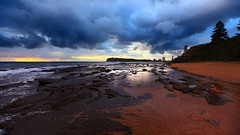
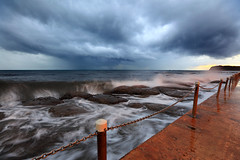



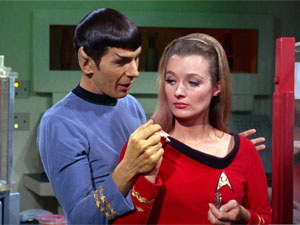 “
“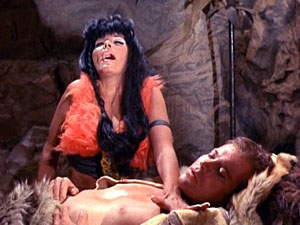 “
“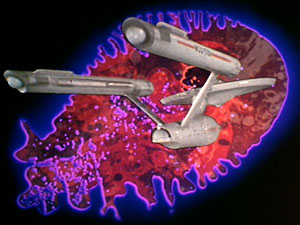 I couldn’t remember what “
I couldn’t remember what “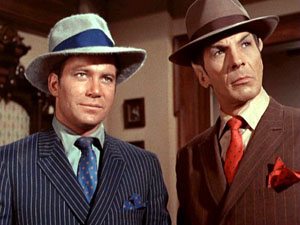 “
“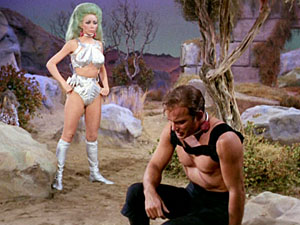 “
“